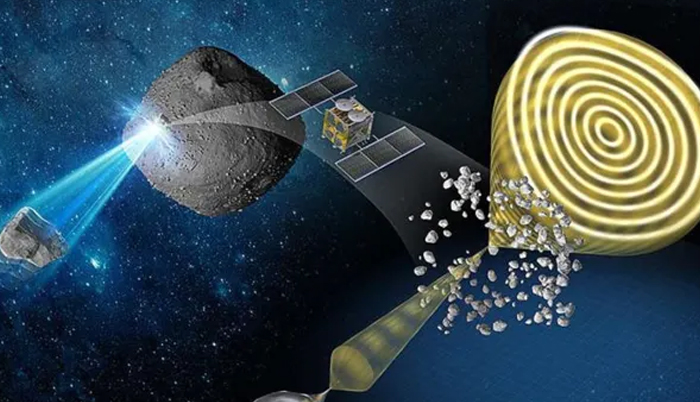![]() Home > Space & Science
Home > Space & Science
Asteroid Ryugu Holds Secrets Of Our Solar System's Past, Present And Future

a rock floats in space against a background of stars with smaller grey spheres and a spacecraft plus a yellow spiral structure (Image credit: Yuki Kimura)
![]() May 2nd, 2024 | 10:53 AM |
May 2nd, 2024 | 10:53 AM | ![]() 549 views
549 views
SPACE
"The signatures of space weathering we have detected directly will give us a better understanding of some of the phenomena occurring in the solar system."
Samples collected from asteroid Ryugu appear to hide secrets of the solar system's past, the bombardment that asteroids presently endure as they drift between planets, and perhaps even the blueprints for future asteroid mining missions.
As asteroids explore interplanetary space, they are exposed to high-energy particles jettisoned from the sun in the form of the solar wind as well as small bodies called micrometeoroids. These interplanetary environmental factors can cause "space-weathering" — but they're difficult to see remotely. In fact, meteorites that break away from asteroids endure intense heating as they pass through Earth's atmosphere to reach our planet's surface, which also means such changes are not evident in asteroid samples that make their way here.
The effects of interplanetary space are evident in samples collected directly from asteroids, however. And this is something humanity has been looking into lately, with NASA's OSIRIS-REx mission, for instance, and of course Japan's Hayabusa2 spacecraft. The samples used by the team, led by Hokkaido University's Yuki Kimura, are associated with the latter.
The Hayabusa2 mission rendezvoused with Ryugu three and a half years after its launch in June 2014. Haybusa2 spent a year with the asteroid, which has a diameter of around 3,000 feet (900 meters), before dipping down and scooping a sample from its surface in June 2018. This Ryugu sample returned to Earth on Dec. 6, 2020, as Haybusa2 headed off to study other asteroids.
"The signatures of space weathering we have detected directly will give us a better understanding of some of the phenomena occurring in the solar system," Kimura explained.
Planning for space missions with Ryugu
One intriguing result Kimura and colleagues discovered in Hayabusa2's Ryugu samples was the presence of small mineral grains called framboids. These framboids were composed of iron oxide, yet appeared to have completely lost their usual magnetic properties. The team suggests that this resulted from micrometeoroids no wider than 0.002 centimeters bombarding Ryugu.
Furthermore, the Ryugu samples may not just be useful in determining conditions found in the solar system today. Because asteroids are formed from material around the sun leftover from the formation of the planets about 4.6 billion years ago, they contain a "fossil record" of conditions in the early solar system, too.
Kimura says the strength of the early solar system's magnetic field decreased as planets formed. Measuring the remaining magnetization of asteroids via samples like those collected with Hayabusa2 can thus help reveal information details about the infant solar system's magnetic fields.
In Ryugu samples, this fossil record of the solar system's magnetic field seems locked up in the thousands of iron nanoparticles surrounding those framboids, however. The team hopes to soon unlock the secrets of these iron nanoparticles and, hopefully, reveal what conditions are in store for early solar system in the near future.
There is also a commercial aspect to the team's research, and one that could help shape the solar system's future, in a way. Studies like this one could be key to developing future space mining operations, for instance, that aim to strip resources from asteroids.
"Although our study is primarily for fundamental scientific interest and understanding, it could also help estimate the degree of degradation likely to be caused by space dust impacting robotic or manned spacecraft at high velocity," Kimura concluded.
The team's research was published on Monday (April 29) in the journal Nature Communications.
Source:
courtesy of SPACE
by Robert Lea
If you have any stories or news that you would like to share with the global online community, please feel free to share it with us by contacting us directly at [email protected]